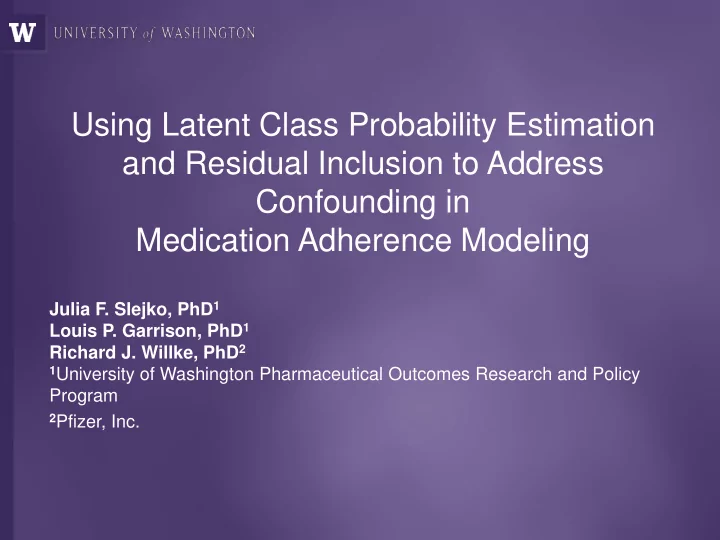

Using Latent Class Probability Estimation and Residual Inclusion to Address Confounding in Medication Adherence Modeling Julia F. Slejko, PhD 1 Louis P. Garrison, PhD 1 Richard J. Willke, PhD 2 1 University of Washington Pharmaceutical Outcomes Research and Policy Program 2 Pfizer, Inc.
Background: Medication Adherence • Often suboptimal and variable in chronic disease settings. • Using claims data, we find some patient characteristics are associated with adherence. • Patterns of adherence may also be associated with characteristics that we cannot observe.
Challenge Patient Characteristics Statin Adherence CV Outcomes • Difficult to estimate the association between adherence and outcomes, partly due to potential confounding by unobserved patient characteristics.
Objectives • To characterize variation and predictors of medication adherence. • To improve the ability to explain the effect of adherence on outcomes by adjusting for unobserved confounders.
Methods • Cohort definition, adherence estimation • Three-part analysis: 1. Characterize adherence variation 2. Estimate probability of adherence 3. Associate adherence and outcomes
“Real - World” Adherence • 10% random sample of the IMS LifeLink Integrated Patient-Centric Claims (5.6 million), 1997- 2008 • Adult new statin users for primary prevention – In prior 12 months, no cardiovascular diagnoses or statin use (n=20,858) • Minimum two-year follow-up • Adherence measured as yearly Proportion of Days Covered (PDC) 6
Adherence and CV risk 4 years: follow-up cardiovascular events 5 Years Index statin Rx Time= 0 Adherence: Adherence: 7 Year 1 Year 2
Cohort Characteristics Characteristic Study Cohort Total N = 20,858 Male n (%) 10,382 (49.77%) Mean age in years (SD) 55.18 (10.6) (Range: 18-96) No healthy behaviors n (%) 11,853 (56.83%) (e.g., flu shot, physical, etc.) Chronic disease indicator score (SD) 4.79 (2.92) (Range: 1-23) (measure of comorbidity using Rx claims) Generic statin (vs. brand) n (%) 2,215 (10.62%) CV Event (MI, stroke) n (%) 1,522 7.30%
Distribution of Adherence: Years 1 & 2 Kernel density estimate Kernel density estimate 2.5 2.5 2 2 1.5 1.5 1 1 .5 .5 0 0 .2 .4 .6 .8 1 0 .2 .4 .6 .8 1 Year One Adherence (PDC) Year Two Adherence (PDC) kernel = epanechnikov, bandwidth = 0.0387 kernel = epanechnikov, bandwidth = 0.0470 • Appears that high- and low-adherers exist. • Variation in adherence behavior.
Finite Mixture Model • Model scenario where >1 distributions exist. • Allows one to identify and estimate the parameters of interest for each sub-population in the data, not just of the overall mixed population • Provides a natural representation of unobserved heterogeneity in a finite number of latent classes Year 2 adherence = α + β 1 male + β 2 age + β 3 generic statin + β 4 healthy behavior + β 5 chronic disease indicator + ε
Part 1: FMM Results Change in year 2 N=20,858 adherence P>z [95%Conf. Interval] Class 1 Male 0.032 <0.001 0.020 0.044 Age 0.003 <0.001 0.003 0.004 No healthy behaviors -0.065 <0.001 -0.077 -0.053 CDI 0.000 0.898 -0.002 0.002 Generic -0.017 0.077 -0.036 0.002 Constant 0.201 0.000 0.169 0.233 Probability 67.41% 0.000 66.39% 68.41% Class 2 Male 0.001 0.654 -0.002 0.003 Age 0.001 <0.001 0.001 0.001 No healthy behaviors -0.008 <0.001 -0.010 -0.005 CDI 0.001 0.006 0.000 0.001 Generic -0.001 0.670 -0.005 0.003 Constant 0.911 <0.001 0.901 0.920 Probability 32.59% 31.59% 33.61%
Who is in each component? Classification of subjects based on most likely latent class membership. N=20,858 Frequency Percent Mean Adherence Class 1 “Low” 13,632 65.37 32.73% Class 2 “High” 7,224 34.63 95.46%
Determinants of Posterior Probability • Ordinary least squares regression Class 2 posterior probability = α + β 1 male + β 2 age + β 3 generic statin + β 4 healthy behavior + β 5 chronic disease indicator + ε
Part 2: Results Determinants of Class 2 posterior probability. N=20,858 Coef. P>t [95% Conf. Interval] Male 0.045 <0.001 0.033 0.057 Age 0.005 <0.001 0.005 0.006 No healthy behaviors -0.051 <0.001 -0.062 -0.039 CDI 0.000 0.951 -0.002 0.002 Generic 0.003 0.716 -0.015 0.022 _cons 0.045 0.007 0.012 0.079
Modeling Adherence and CV risk • Cox proportional hazards model • Up to 5-year risk of vascular events (MI, Stroke) – Follow-up: mean 42 months (range 24-119) • Excluded patients with Year 1 CV events. log h i CVEvent(t) =β 1 Year 2 Adherence + β 2 male + β 3 age + β 4 CDI + ε log h i CVEvent(t) =β 1 Year 2 Adherence + β 2 male + β 3 age + β 4 CDI + β 4 Part 2 residual + ε 15
Part 3: Cox Proportional Hazards Results N=20,858 Hazard Ratio P>z [95%Conf. Interval] Model 1 Adherence 0.676 <0.001 0.594 0.769 Male 1.238 <0.001 1.117 1.373 Age 1.055 <0.001 1.051 1.060 CDI 1.190 <0.001 1.174 1.206 Model 2 Adherence 0.530 <0.001 0.427 0.658 Male 1.251 <0.001 1.128 1.387 Age 1.057 <0.001 1.052 1.062 CDI 1.190 <0.001 1.174 1.207 Residual (covariate) 1.328 0.006 1.086 1.624
Limitations • Using pharmacy claims for adherence estimation. • Patient censoring. • Structural uncertainty.
Conclusions • FMM allows analysis of heterogeneity in statin adherence. • Patient characteristics are associated with likelihood of adherence. • Unobserved determinants can be captured and used to investigate true effect of adherence on outcomes.
Future Work • Model structure. • Validation data set to investigate residuals.
Questions slejko@uw.edu
Recommend
More recommend